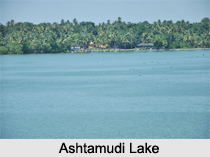 History of Kollam district reveals that it has been a major centre of trade and commerce since ancient times. Also known as Quilon, Kollam is an old sea port town standing along the Arabian coast on the Ashtamudi Lake. Kollam, the erstwhile Desinganadu, had a sustained commercial reputation from the days of the Phoenicians and the Romans. Fed by the Chinese trade, it was regarded by Ibn Batuta, as one of the five ports, which he had seen in the course of his travels during a period of twenty four years, in the 14th century.
History of Kollam district reveals that it has been a major centre of trade and commerce since ancient times. Also known as Quilon, Kollam is an old sea port town standing along the Arabian coast on the Ashtamudi Lake. Kollam, the erstwhile Desinganadu, had a sustained commercial reputation from the days of the Phoenicians and the Romans. Fed by the Chinese trade, it was regarded by Ibn Batuta, as one of the five ports, which he had seen in the course of his travels during a period of twenty four years, in the 14th century.
There has been a long line of travellers and merchants who have held Kollam in high esteem as a commercial town. The rulers of Kollam and China, exchanged embassies and consequently, there was flourishing Chinese settlement at Kollam. Merchant Sulaiman of Siraf in Persia (9th Century) found Kollam to be the only port in India, touched by the huge Chinese junks, on his way from Carton in the Persian Gulf. Marco Polo, the great Venetian traveller, who was in Chinese service under Kubla Khan in 1275, visited Kollam and other towns on the west coast, in his capacity as a Chinese mandarin.
The Portuguese were the first Europeans to establish a trading centre at Kollam in 1502. Then came the Dutch followed by the British in 1795. A British garrison was stationed at Kollam in pursuance of a treaty between Travancore and the British. Velu Thampi Dalawa of Travancore did much for the improvement of the Kollam town. He built new bazaars and invited merchants from Chennai and Tirunelveli to settle here. Kollam later became the capital of the enlightened and liberal rulers of Desinganad.
The history of the district as an administrative unit can be traced back to 1835, when the Travancore state consisted of two revenue divisions with headquarters at Kollam and Kottayam. At the time of the integration of Travancore and Cochin in 1949, Kollam was one of the three revenue divisions in the state. These three revenue divisions were converted into districts. Shencottah taluk was merged with the state of Chennai consequent to the implementation of the state Reorganisation Act of 1956. When Alappuzha district was formed in 1957, Cherthala, Ambalapuzha, Mavelikkara, Karthikappally, Chenganuur and Thiruvalla Taluks were united to the new district. When Pathanamthitta District was formed on 1st July 1983, the entire Pathanamthitta Taluk and nine villages of Kunnathur Taluk of the district were also removed. Now the district has a single revenue division with headquarters at Kollam. Pathanapuram, Kunnathur, Kottarakkara, Karunagappally and Kollam are the five taluks in the district.



















